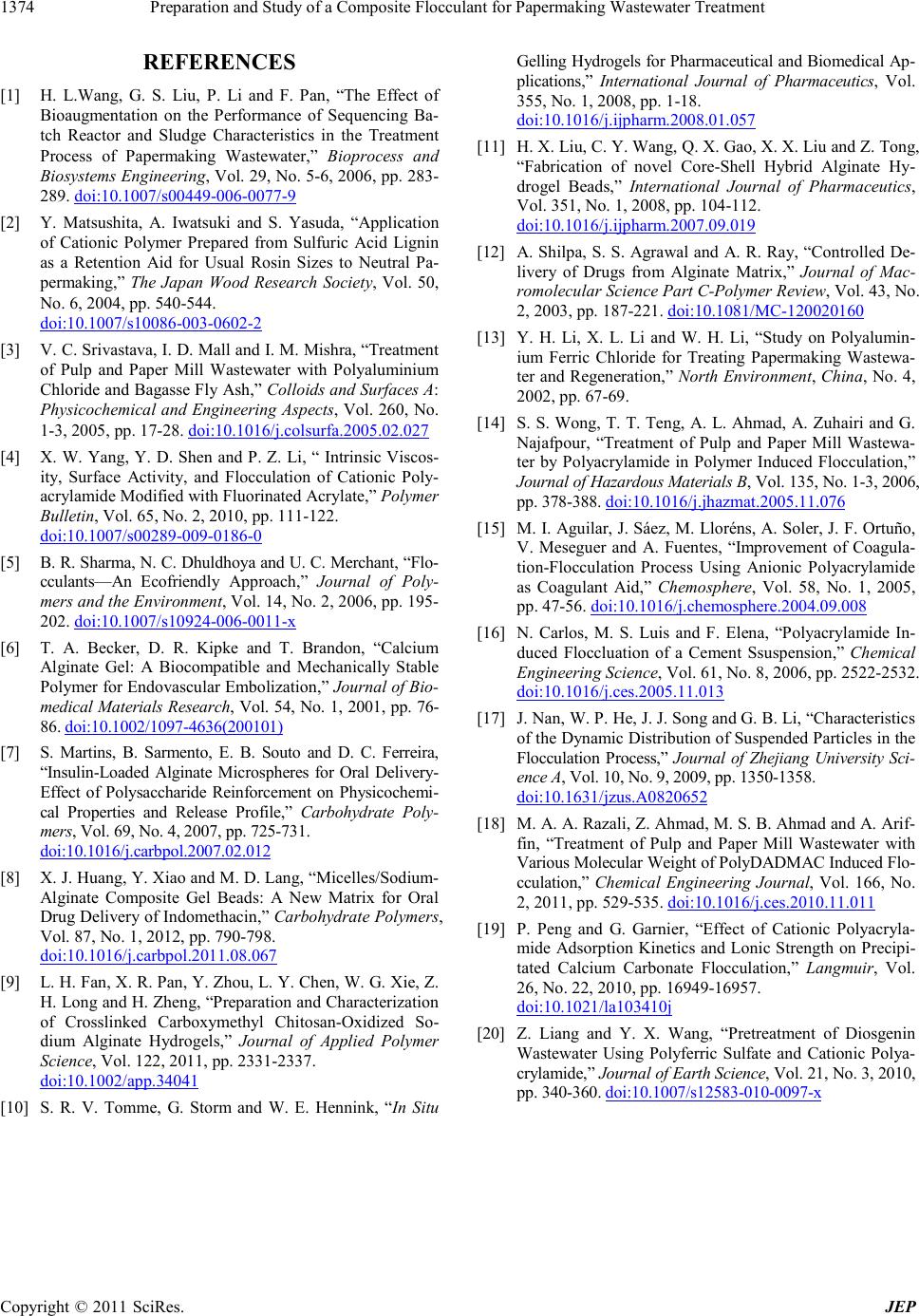
Preparation and Study of a Composite Flocculant for Papermaking Wastewater Treatment
Copyright © 2011 SciRes. JEP
1374
REFERENCES
[1] H. L.Wang, G. S. Liu, P. Li and F. Pan, “The Effect of
Bioaugmentation on the Performance of Sequencing Ba-
tch Reactor and Sludge Characteristics in the Treatment
Process of Papermaking Wastewater,” Bioprocess and
Biosystems Engineering, Vol. 29, No. 5-6, 2006, pp. 283-
289. doi:10.1007/s00449-006-0077-9
[2] Y. Matsushita, A. Iwatsuki and S. Yasuda, “Application
of Cationic Polymer Prepared from Sulfuric Acid Lignin
as a Retention Aid for Usual Rosin Sizes to Neutral Pa-
permaking,” The Japan Wood Research Society, Vol. 50,
No. 6, 2004, pp. 540-544.
do i:10. 1007/ s 10086-003-0602-2
[3] V. C. Srivastava, I. D. Mall and I. M. Mishra, “Treatment
of Pulp and Paper Mill Wastewater with Polyaluminium
Chloride and Bagasse Fly Ash,” Colloids and Surfaces A:
Physicochemical and Engineering Aspects, Vol. 260, No.
1-3, 2005, pp. 17-28. doi:10.1016/j.colsurfa.2005.02.027
[4] X. W. Yang, Y. D. Shen and P. Z. Li, “ Intrinsic Viscos-
ity, Surface Activity, and Flocculation of Cationic Poly-
acrylamide Modified with Fluorinated Acrylate,” Polymer
Bulletin, Vol. 65, No. 2, 2010, pp. 111-122.
do i:10. 1007/ s 00289-009-0186-0
[5] B. R. Sharma, N. C. Dhuldhoya and U. C. Merchant, “Flo-
cculants—An Ecofriendly Approach,” Journal of Poly-
mers and the Environment, Vol. 14, No. 2, 2006, pp. 195-
202. doi:10.1007/s10924-006-0011-x
[6] T. A. Becker, D. R. Kipke and T. Brandon, “Calcium
Alginate Gel: A Biocompatible and Mechanically Stable
Polymer for Endovascular Embolization,” Journal of Bio-
medical Materials Research, Vol. 54, No. 1, 2001, pp. 76-
86. doi:10.1002/1097-4636(200101)
[7] S. Martins, B. Sarmento, E. B. Souto and D. C. Ferreira,
“Insulin-Loaded Alginate Microspheres for Oral Delivery-
Effect of Polysaccharide Reinforcement on Physicochemi-
cal Properties and Release Profile,” Carbohydrate Poly-
mers, Vol. 69, No. 4, 2007, pp. 725-731.
doi:10.1016/j.carbpol.2007.02.012
[8] X. J. Huang, Y. Xiao and M. D. Lang, “Micelles/Sodium-
Alginate Composite Gel Beads: A New Matrix for Oral
Drug Delivery of Indomethacin,” Carbohydrate Polymers,
Vol. 87, No. 1, 2012, pp. 790-798.
do i :10.1016/ j.carbpol .2011.08. 067
[9] L. H. Fan, X. R. Pan, Y. Zhou, L. Y. Chen, W. G. Xie, Z.
H. Long and H. Zheng, “Preparation and Characterization
of Crosslinked Carboxymethyl Chitosan-Oxidized So-
dium Alginate Hydrogels,” Journal of Applied Polymer
Science, Vol. 122, 2011, pp. 2331-2337.
doi:10.1002/app.34041
[10] S. R. V. Tomme, G. Storm and W. E. Hennink, “In Situ
Gelling Hydrogels for Pharmaceutical and Biomedical Ap-
plications,” International Journal of Pharmaceutics, Vol.
355, No. 1, 2008, pp. 1-18.
doi:10.1016/j.ijpharm.2008.01.057
[11] H. X. Liu, C. Y. Wang, Q. X. Gao, X. X. Liu and Z. Tong,
“Fabrication of novel Core-Shell Hybrid Alginate Hy-
drogel Beads,” International Journal of Pharmaceutics,
Vol. 351, No. 1, 2008, pp. 104-112.
doi:10.1016/j.ijpharm.2007.09.019
[12] A. Shilpa, S. S. Agrawal and A. R. Ray, “Controlled De-
livery of Drugs from Alginate Matrix,” Journal of Mac-
romolecular Science Part C-Polymer Review, Vol. 43, No.
2, 2003, pp. 187-221. doi:10.1081/MC-120020160
[13] Y. H. Li, X. L. Li and W. H. Li, “Study on Polyalumin-
ium Ferric Chloride for Treating Papermaking Wastewa-
ter and Regeneration,” North Environment, China, No. 4,
2002, pp. 67-69.
[14] S. S. Wong, T. T. Teng, A. L. Ahmad, A. Zuhairi and G.
Najafpour, “Treatment of Pulp and Paper Mill Wastewa-
ter by Polyacrylamide in Polymer Induced Flocculation,”
Journal of Hazardous Materials B, Vol. 135, No. 1-3, 2006,
pp. 378-388. doi:10.1016/j.jhazmat.2005.11.076
[15] M. I. Aguilar, J. Sáez, M. Lloréns, A. Soler, J. F. Ortuño,
V. Meseguer and A. Fuentes, “Improvement of Coagula-
tion-Flocculation Process Using Anionic Polyacrylamide
as Coagulant Aid,” Chemosphere, Vol. 58, No. 1, 2005,
pp. 47-56. doi:10.1016/j.chemosphere.2004.09.008
[16] N. Carlos, M. S. Luis and F. Elena, “Polyacrylamide In-
duced Floccluation of a Cement Ssuspension,” Chemical
Engineering Science, Vol. 61, No. 8, 2006, pp. 2522-2532.
do i :10.1016/ j.ces.2005.11.013
[17] J. Nan, W. P. He, J. J. Song and G. B. Li, “Characteristics
of the Dynamic Distribution of Suspended Particles in the
Flocculation Process,” Journal of Zhejiang University Sci-
ence A, Vol. 10, No. 9, 2009, pp. 1350-1358.
doi:10.1631/jzus.A0820652
[18] M. A. A. Razali, Z. Ahmad, M. S. B. Ahmad and A. Arif-
fin, “Treatment of Pulp and Paper Mill Wastewater with
Various Molecular Weight of PolyDADMAC Induced Flo-
cculation,” Chemical Engineering Journal, Vol. 166, No.
2, 2011, pp. 529-535. doi:10.1016/j.ces.2010.11.011
[19] P. Peng and G. Garnier, “Effect of Cationic Polyacryla-
mide Adsorption Kinetics and Lonic Strength on Precipi-
tated Calcium Carbonate Flocculation,” Langmuir, Vol.
26, No. 22, 2010, pp. 16949-16957.
do i:10. 1021/ la103410j
[20] Z. Liang and Y. X. Wang, “Pretreatment of Diosgenin
Wastewater Using Polyferric Sulfate and Cationic Polya-
crylamide,” Journal of Earth Science, Vol. 21, No. 3, 2010,
pp. 340-360. doi:10.1007/s12583-010-0097-x